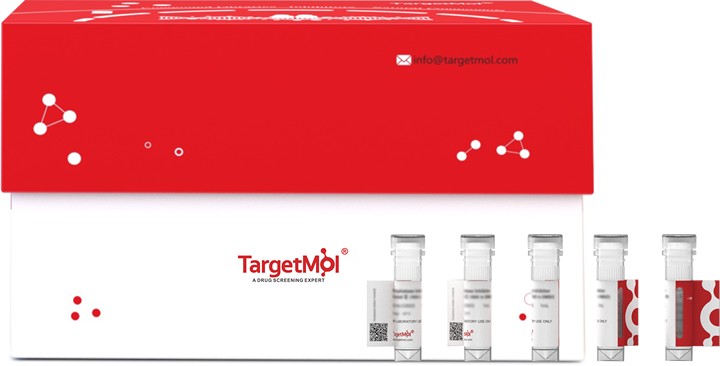 Your shopping cart is currently empty
Your shopping cart is currently empty
CLIC1 Protein, Human, Recombinant (His)
Members of the CLIC family are largely soluble proteins that possess the intriguing property of spontaneous insertion into phospholipid bilayers to form integral membrane ion channels. Chloride intracellular channel 1 (CLIC1), a newly discovered member of the chloride channel protein family, has been implicated in multiple human cancers. CLIC1 is a Chloride Intracellular Ion Channel protein that exists either in a soluble state in the cytoplasm or as a membrane bound protein. CLIC1 acts as a putative oncogene in pancreatic cancer and may represent a novel diagnostic and therapeutic target for pancreatic cancer. Intracellular chloride channel protein 1 (CLIC1) participates in inflammatory processes by regulating macrophage phagosomal functions such as pH and proteolysis. CLIC1 is a novel therapeutic target to help reduce the adaptive immune response in autoimmune diseases. The expression of CLIC1 might be closely related to the carcinogenesis, clinical biological behaviors, and prognosis of pancreatic ductal adenocarcinomas. Intracellular chloride channel 1 (CLIC1), a novel metamorphic protein, acts as a sensor of cell oxidation and is involved in inflammation.

CLIC1 Protein, Human, Recombinant (His)
| Pack Size | Price | USA Warehouse | Global Warehouse | Quantity |
|---|---|---|---|---|
| 5 μg | $68 | 7-10 days | 7-10 days | |
| 10 μg | $108 | 7-10 days | 7-10 days | |
| 20 μg | $178 | 7-10 days | 7-10 days | |
| 50 μg | $359 | 7-10 days | 7-10 days | |
| 100 μg | $696 | 7-10 days | 7-10 days |
Product Information
| Biological Activity | Activity testing is in progress. It is theoretically active, but we cannot guarantee it. If you require protein activity, we recommend choosing the eukaryotic expression version first. |
| Description | Members of the CLIC family are largely soluble proteins that possess the intriguing property of spontaneous insertion into phospholipid bilayers to form integral membrane ion channels. Chloride intracellular channel 1 (CLIC1), a newly discovered member of the chloride channel protein family, has been implicated in multiple human cancers. CLIC1 is a Chloride Intracellular Ion Channel protein that exists either in a soluble state in the cytoplasm or as a membrane bound protein. CLIC1 acts as a putative oncogene in pancreatic cancer and may represent a novel diagnostic and therapeutic target for pancreatic cancer. Intracellular chloride channel protein 1 (CLIC1) participates in inflammatory processes by regulating macrophage phagosomal functions such as pH and proteolysis. CLIC1 is a novel therapeutic target to help reduce the adaptive immune response in autoimmune diseases. The expression of CLIC1 might be closely related to the carcinogenesis, clinical biological behaviors, and prognosis of pancreatic ductal adenocarcinomas. Intracellular chloride channel 1 (CLIC1), a novel metamorphic protein, acts as a sensor of cell oxidation and is involved in inflammation. |
| Species | Human |
| Expression System | E. coli |
| Tag | N-6xHis |
| Accession Number | O00299 |
| Synonyms | NCC27,G6,chloride intracellular channel 1 |
| Construction | Met1-Lys241 |
| Protein Purity | > 90% as determined by SDS-PAGE |
| Molecular Weight | 29 kDa (predicted); 30-35 kDa (reducing conditions) |
| Endotoxin | < 1 EU/µg as determined by LAL test. |
| Formulation | Lyophilized from a 0.2 μm filtered solution of 20mM Tris-HCl, 100mM NaCl, pH 8.0. |
| Reconstitution | Reconstitute the lyophilized protein in distilled water. The product concentration should not be less than 100 μg/ml. Before opening, centrifuge the tube to collect powder at the bottom. After adding the reconstitution buffer, avoid vortexing or pipetting for mixing. |
| Stability & Storage | It is recommended to store recombinant proteins at -20°C to -80°C for future use. Lyophilized powders can be stably stored for over 12 months, while liquid products can be stored for 6-12 months at -80°C. For reconstituted protein solutions, the solution can be stored at -20°C to -80°C for at least 3 months. Please avoid multiple freeze-thaw cycles and store products in aliquots. |
| Shipping | In general, Lyophilized powders are shipping with blue ice. |
| Research Background | Members of the CLIC family are largely soluble proteins that possess the intriguing property of spontaneous insertion into phospholipid bilayers to form integral membrane ion channels. Chloride intracellular channel 1 (CLIC1), a newly discovered member of the chloride channel protein family, has been implicated in multiple human cancers. CLIC1 is a Chloride Intracellular Ion Channel protein that exists either in a soluble state in the cytoplasm or as a membrane bound protein. CLIC1 acts as a putative oncogene in pancreatic cancer and may represent a novel diagnostic and therapeutic target for pancreatic cancer. Intracellular chloride channel protein 1 (CLIC1) participates in inflammatory processes by regulating macrophage phagosomal functions such as pH and proteolysis. CLIC1 is a novel therapeutic target to help reduce the adaptive immune response in autoimmune diseases. The expression of CLIC1 might be closely related to the carcinogenesis, clinical biological behaviors, and prognosis of pancreatic ductal adenocarcinomas. Intracellular chloride channel 1 (CLIC1), a novel metamorphic protein, acts as a sensor of cell oxidation and is involved in inflammation. |
Dose Conversion
Calculator
Tech Support
| Size | Quantity | Unit Price | Amount | Operation |
|---|

Copyright © 2015-2026 TargetMol Chemicals Inc. All Rights Reserved.



